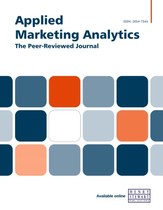Marketing return on investment: Seeking clarity for concept and measurement
Abstract
As the need for accountable marketing spending continues to grow, companies must develop sound metrics and measures of marketing’s contribution to firm profitability. The leading metric has been return on marketing investment (MROI), following the widespread adoption of ROI metrics in other parts of the organisation. However, the ROI metric in marketing is typically interpreted and used in a variety of ways, which causes ambiguity and suboptimal marketing decision making. This paper seeks to remove the ambiguity around MROI to guide better measurements and analytics aligned to financial contribution. The authors first provide a formal definition of MROI and review variations in the use of MROI that are the root cause of ambiguity in interpretation. The authors come to the conclusion that MROI estimates would be more transparently described if those providing the estimates used the following form: Our analysis measured a (total, incremental, or marginal) MROI of (scope of spending) using (valuation method) over time period. The paper proceeds to describe five case studies that illustrate the various uses of MROI, covering different marketing initiatives in different business sectors. The authors describe the important links between marketing lift metrics (such as response elasticities) and MROI. The final section of the paper focuses on the connection between MROI and business objectives. While management’s prerogative is to maximise short- and long-run profits, that is not equivalent to maximising MROI. The authors demonstrate that MROI plays a different role in the process of marketing budget setting (a marketing strategic task) versus allocating a given budget across different marketing activities (a marketing operations task). They highlight the role of setting MROI hurdle rates that recognise not only marketing’s ability to drive revenue, but also the firm’s cost of capital. The authors hope that their recommendations will help the marketing profession achieve a common understanding of how to assess and use what they believe is its most important summary productivity metric, MROI.
The full article is available to subscribers to the journal.
Author's Biography
Paul W. Farris is the Landmark Communications Professor of Business at the University of Virginia’s Darden School of Business. Previously, he worked in marketing management for UNILEVER, Germany and the LINTAS advertising agency. Professor Farris is a current or past board member for several international companies and is a past academic trustee of the Marketing Science Institute. He is the co-author of award-winning work in marketing metrics, advertising research, advertising budgeting and retail power.
Dominique M. Hanssens is the Bud Knapp Distinguished Professor of Marketing at the UCLA Anderson School of Management. From 2005 to 2007 he served as executive director of the Marketing Science Institute. A Purdue University PhD graduate, Professor Hanssens’ research focuses on strategic marketing problems, in particular marketing productivity. He is a Fellow of the INFORMS Society for Marketing Science and a recipient of the Churchill and Mahajan awards from the American Marketing Association. He is a founding partner of MarketShare, a global marketing analytics firm with headquarters in Los Angeles.
James D. Lenskold is President of Lenskold Group, international speaker and author of the award-winning book ‘Marketing ROI, The Path to Campaign, Customer and Corporate Profitability’. Jim’s firm specialises in building marketing ROI capabilities for Fortune 1000 and emerging companies globally. Client engagements include innovative measurement solutions, user-friendly ROI planning tools, action-driven dashboards and ROI frameworks to drive more profitable marketing strategies and performance.
David J. Reibstein is the William S. Woodside Professor and Professor of Marketing at The Wharton School, University of Pennsylvania. He served as executive director of the Marketing Science Institute and as chairman of the American Marketing Association. He previously taught at Harvard, Stanford, INSEAD and ISB (in India). David has authored seven books and dozens of articles in major marketing journals. His most recent book is ‘Marketing Metrics: The Definitive Guide to Measuring Marketing Performance’. He has consulted for companies ranging from Fortune 500 firms to start-ups, including Google, GE, British Airways and Royal Dutch Shell. David was a co-founder of Bizrate.com (Shopzilla) and on the founding board of And1, the basketball apparel company.
Citation
Farris, Paul W., Hanssens, Dominique M., Lenskold, James D. and Reibstein, David J. (2015, July 29). Marketing return on investment: Seeking clarity for concept and measurement. In the Applied Marketing Analytics: The Peer-Reviewed Journal, Volume 1, Issue 3. https://doi.org/10.69554/FFOM1594.Publications LLP
